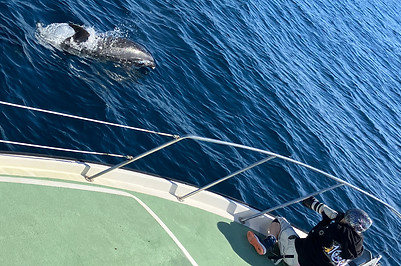
The goal of our project is to provide a long term health reading of the delicate marine ecosystem off Ancapa Island, by investigating with established standard methods top predators such as whales and dolphins, to map their distribution and the one of their target preys, as well as collect behavioural observations in the different seasons of the year with continuity. To do so, we employ a mix of Focal follow and remote sensing techniques. The idea is to conduct very fine-scale acoustics surveys around cetaceans habitats and to compare preys' density in feeding areas with non-feeding areas during mark recapture experiments and run a monthly survey to describe seasonal habitat variation with high accuracy . We want to determine the prey-density threshold for foraging to inform energetic mathematical models and predict (a long way down the line) how climate-related changes in prey density might impact in long term the Cetaceans populations of the Channel Island National Marine Sanctuary. The long term nature of our effort, with sometimes the involvement of our ecotours clients, should allow us to spend much more time on the water collecting data increasing the typical frequency of surveys and hopefully decreasing the imprecision of our estimates. We believe a continuous effort could boost the detection of precipitous changes and help to act promptly if early warning signs of population declines come to light and timely advise conservation and management actions.
How do we do that?
HABITAT USE, DISTRIBUTION AND SITE FIDELITY
To investigate the Habitat preference and Distribution of Cetaceans we collect in-situ several Eco-Geographic explanatory variables (E.G. Water Temperature, Salinity, Wind Direction and Speed etc) at predetermined station and once we conclude a Mark Recapture Sighting. The Mark Recapture definition may sound scary, but in reality with cetaceans the technique adoptet is contactless simply performed by taking a picture. Like humans can be identified by fingerprints, cetaceans can be individually recognized by the shape contour of their fins or their flukes.
At all time, we are also recording echograms to asses prey biomass in the area where our observations take place. That help us to understand for instance how to interpret the whales and dolphins behavioral display in relation to the presence or absence of prey.


THE RESEARCH TEAM
Director of Operations
Dr Matteo Bernasconi - Whales & Co. / University of St Andrews
Principal Investigators
Dr Salome' Dussan-Duque - Whales & Co. / University of St Andrews
Research Team
Dr Sven Gastauer – Thünen Institute of Sea Fisheries (Germany)
Dr Geir Pedersen – Institute of Marine Research (Norway)
Dr Tom Letessier - Zoological Society of London (United Kingdom)
Mr Antoine Bouvet - Whales & Co. IT Manager (France)
Advisors
Prof Andrew S Brierley - University of St Andrews (United Kingdom)
Prof Peter Evans - Seawatch Foundation (United Kingdom)
Prof Phil Hammond - University of St Andrews
r Randall Wells - MOTE Marine Laboratory
Dr David Deemer - NOAA SWFD San Diego
Students
Find # 1 - St Andrews
Find # 2 - Oxnard or SB
ESTIMATING THE AGE-CLASS OF FREE RANGING DOLPHINS USING DRONES
When dolphins come to the surface to breathe, they expose their blowhole and dorsal fin. By measuring the distance between the two, it is possible to estimate the total body length. Since total length is related to age, it is possible of inferring age based on length for each measured dolphin within a group. Results in the field are obtained by using AUV and digital photogrammetry. This for us is a work in progress but there is enough scientific literature to test the feasibility of this method in our Study Area and to use it also to measure the extension of large krill patches.



PREY BIOMASS ESTIMATION
Acoustic surveys are used in the monitoring and management of many fish species, including herrings, anchovies, sardines, Atlantic cod, and walleye pollock. Fisheries scientists use active acoustics to estimate fish biomass and abundance (stock assessment); evaluate spatial and temporal distributions; and measure size distributions and population structure. In addition, these methods can also be used to characterize habitats and study behaviors such as migration, spawning, feeding, and schooling. Active acoustic methods allow researchers to sample larger volumes of water than by towed net sampling and to access areas or species that are otherwise difficult to survey (e.g. deep water, rugged bathymetry, or fast-moving fishes that avoid nets).
Scientific echosounders operate similarly to commercially available “fish finders” by producing a brief, focused pulse of sound and listening for echoes. When the sound encounters objects that are of different acoustic impedance than the surrounding water, such as fish or the seafloor, some of the sound energy is reflected back to the transducer and translated into a digital output on a monitor (echogram). An echogram can include images of both single objects and groups of objects.
CTD CASTs
CTDs are common equipment in oceanography because they measure chemical and physical properties of the water column, which serve as a foundation for understanding the marine environment. A CTD device’s primary function is to measure the Conductivity and Temperature of the water column in relation with Depth. Conductivity is a measure of how well a solution conducts electricity and it is directly related to salinity. By measuring conductivity of seawater, Salinity can be obtain mathematically. In Acoustics, CTD data are important part of the calibration process before biomass can be extimated.
CTD data help us understand biological processes such as the distribution of fish species that rely on specific temperatures and salinities to regulate their life cycle as well as where important commercial fish species may occur in the oceans.


